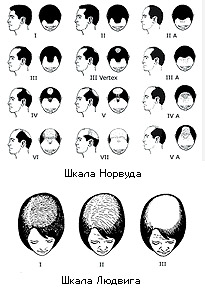Alopecia
Alopecia is a disease causing hair loss (effluvium, deffluvium). Diseases characterized by hair loss are divided into
- non-scarring alopecia (clinically without signs of tissue damage);
- and scarring alopecia (clinically noticeable tissue destruction on the scalp).
Division[edit | edit source]
Non-scarring alopecia[edit | edit source]
- Diffuse alopecia
- Androgenic alopecia (AGA)
- Telogen effluvium
- Anagen effluvium
- Alopecia of endocrine origin
- Alopecia in internal diseases, some infectious diseases and CNS disorders
- Traumatic alopecia
- Alopecia areata
Scarring Alopecia[edit | edit source]
- Pseudopelade Brocq
- Alopecia mucinosa
- Congenital alopecia and hypotrichosis
Non-scarring alopecia[edit | edit source]
Alopecia that does not clinically cause any damage to the skin of the scalp.
Diffuse alopecia[edit | edit source]
It is diffuse, reversible hair loss. It is referred to when the daily loss of hair is greater than 100 hairs.
Etiology and pathogenesis
Physiologically, it occurs in newborns, partly also in puberty and in old age. Diffuse hair loss also occurs after fevers, systemic diseases, operations, traumatic shocks, weight loss treatments or stressful situations. Certain drugs (thallium, cytostatics) and ionizing radiation also have a toxic effect on the hair follicle.
Androgenic alopecia (AGA)[edit | edit source]
It is a genetically determined disease, polygenic inheritance and the hormone testosterone are used.
- Clinical picture
Androgenic alopecia has a characteristic appearance. The hairline recedes from the forehead or crown, leaving only a horseshoe-shaped strip of hair on the sides and back of the head. The bald spot is sharply defined, the skin is not atrophic and fine lanuginous hair is present on it.
Telogen Effluvium[edit | edit source]
It is excessive loss of normal hair during the premature transition of anagen to telogen hair as a result of the action of weaker noxia. A number of factors play a role in the etiology, such as fever, sudden reduction in food intake, psychological stress or surgical procedures.
- Clinical picture
Diffuse thinning of the hairline appears, the patient reports massive hair loss, especially when washing the head or combing (up to 1000 hairs per day).
Anagen effluvium[edit | edit source]
Due to the action of certain drugs or ionizing radiation, almost complete hair loss will occur within a very short time due to the toxic effect on the hair follicle.
Alopecia of endocrine origin[edit | edit source]
Diffuse alopecia can also be caused by disorders of the thyroid gland (hypothyroidism and hyperthyroidism) and parathyroid glands (hypoparathyroidism). Another factor may be pregnancy.
Alopecia in internal diseases, some infectious diseases and CNS disorders[edit | edit source]
Chronic internal diseases (cirrhosis, hepatitis) or cancer can lead to hair loss. Among infectious diseases, alopecia can be caused by, for example, syphilis.
Alopecia of traumatic origin[edit | edit source]
Hair loss occurs in places of repeated trauma. Occipital alopecia appears in newborns (by rubbing against the mat). Tensile and pressure alopecia appears (by tying the hair in a ponytail, or pressure from hairpins). A special type of traumatic alopecia is trichotillomania - a disease of psychological origin, which manifests itself in the fact that the patient pulls out his hair.
Limited hair loss[edit | edit source]
Alopecia areata[edit | edit source]
It is reversible, rapid and complete demarcated loss of hair in the mane, eyebrows, beard and elsewhere on the body. It occurs most often in children and adolescents. There is no scarring. It is an inflammatory disease.
- Clinical picture
Mostly round, sometimes confluent, sharply demarcated bald deposits, in the edges of which narrowed hairs are visible at a distance from the skin. Hair can fall out on the whole head (alopecia totalis) or on the whole body (alopecia universalis).
Scarring Alopecia[edit | edit source]
Scarring alopecia include a number of processes that are characterized by scarring. This includes bacterial, fungal, viral and other infections, mechanical or physical damage, tumor process.
Pseudopelade Brocq[edit | edit source]
It is a clinical term that represents the final stage of various known and unknown mechanisms that lead to the emergence of scarring irreversible alopecia. The etiology is unknown.
- Clinical picture
The appearance of one or more guttate bald spots on the crown or occiput. Their fusion creates deposits with whitish, tense and atrophic skin. Inflammatory changes are absent.
Alopecia mucinosa[edit | edit source]
This disease is characterized by infiltrated erythematosquamous plaques with scaling in the capilium and the development of temporary or permanent alopecia. Alopecia mucinosa can also occur as part of the clinical picture mycosis fungoides.
Congenital alopecia and hypotrichosis[edit | edit source]
They represent a relatively disparate group of diseases that differ from each other in the type of heredity and degree of disability. These disorders can occur in isolation in otherwise healthy individuals or are part of various hereditary syndromes (Marie-Unna syndrome, ectodermal dysplasia).
Treatment options[edit | edit source]
Treatment options depend on the cause of the disease. In androgenic alopecia, it is possible to apply estrogen to men, sometimes surgical transplantation is successful. In women, we administer antiandrogens. There is no causal treatment available for alopecia areata. Local corticosteroids have a beneficial effect.
Links[edit | edit source]
Related Articles[edit | edit source]
External links[edit | edit source]
References[edit | edit source]
- ŠTORK, Jiří. Dermatovenereology. 1. edition. Galen, Karolinum, 2008. 502 pp. ISBN 978-80-7262-371-6.
- WOLFF, Klaus. Fitzpatrick’s color atlas and synopsis of clinical dermatology. 5. edition. McGraw-Hill Medical Pub. Division, c2005. 1105 pp. ISBN 0-07-144019-4.




